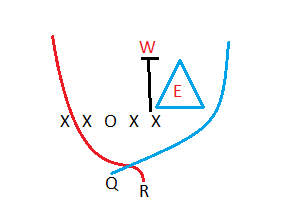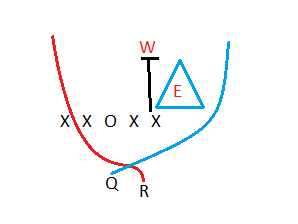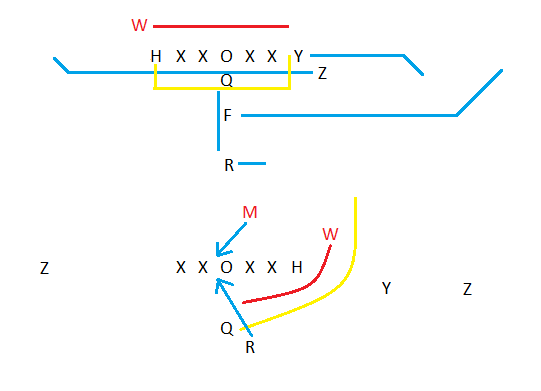Stanford’s offense continued to impress last Friday night as the Cardinal went into Corvallis and beat Oregon State handily. There were a lot of good scoring plays and big gains that I could have looked at, and that’s always a good thing.
So I want to apologize briefly — I won’t be detailing great plays by the Stanford offense, because the offensive plays for which I can legally obtain video footage aren’t actually the best plays to look at today. The biggest play of all — Barry Sanders’ 65-yard touchdown run — was actually a pin-and-pull outside zone, the very same playcall that I covered for the Oregon State game last year. Not coincidentally, that play was also run for Barry Sanders, and it was also a big gain. The other big play that readily comes to mind relies less on scheme and more on a stupidly good throw-and-catch — Michael Rector’s 49-yard touchdown catch in the third quarter.
So I’m going to talk about something else. I’m going to talk about Oregon State’s first touchdown. While it may seem incongruous to examine bad Stanford plays after a game that Stanford won handily, I want to take a look at something people don’t normally think about when they talk about football: how tempo and motion can confuse a defense. Along with pass protection and special teams, pre-snap motion is one of the major things that I rarely get to talk about in this column, and so I’m excited to discuss it with you today.
***
Both of OSU’s first two scores, in fact, were running plays at the goal line. Both of them were, in fact, the same play: the inside zone read. It’s a simple play to understand, if a difficult one to execute, and it’s a play that college coaches install on the very first day of practice. It is not an exaggeration to say that the zone read is the bread-and-butter play of the modern college football world.
(Quick summary: the offensive line leaves the backside player on its flank unblocked, and depending on whether or not the end attacks the handoff, the quarterback either keeps the ball or hands it off, sending the play where the end is not.)
So OSU wasn’t running anything terribly innovative. But it did flash some cute pre-snap motion, which is ironically one of David Shaw’s favorite things in football. People frequently talk about Shaw’s adoration of unconventional formations, but motion is also a big part of the Shaw-Harbaugh school of offense. Because the offense knows where it is going but the defense does not, motion confuses the defense without adding complexity for the offense. It even forces defenses to change their playcalls, which can confuse the defense even more.
***
Oregon State’s first touchdown tied the game up at 7. As I said, the story of the play is motion. Most highlight videos won’t actually show motion, but I went to fairly great lengths — that is to say, I visited not one, not two, but three (!!!) websites looking for a video — to find a set of highlights that didn’t cut the motion out. (You can find the sainted video here — fast forward to 0:14.) The motion is what makes this play go, and in fact, when I watched this play in real time, I was grinning like a loon. (Yes, I’m single. Why do you ask?)
OSU has a first-and-goal at the Stanford 1-yard line, and it wants to punch the ball into the end zone. At the goal line, there’s no threat of a deep pass, so Stanford’s essentially running a zero-safety look. Without the need to drop safeties deep, Stanford enjoys a big numerical advantage: six OSU blockers against six men on the line, plus two linebackers to spare.
Stanford has the numbers and it has the ability — as it turned out, the Cardinal got great push on the play and would have stoned any running back that tried to force his way between the tackles. And it has the know-how — the inside zone read is the simplest play in the book. It’s one that Stanford knows well and should understand how to stop. But Oregon State scored anyway. Why?
All five of OSU’s eligible receivers shifted on this play. And that caused havoc for Stanford’s linebackers. Peter Kalambayi had to shift to the sideline to cover OSU’s flanker (Z), taking one of Stanford’s best players out of the box. Blake Martinez (M) clearly called an audible, and Martinez and Jordan Perez (W) looked like they were still trying to decide who would go where a second before the snap.
It looked like Perez and Martinez were both chasing the running back, when one of them should have taken the running back and the other should have taken the quarterback. Perez actually motioned across the formation, as it looked like he was switching responsibilities with Martinez, who initially seemed to be on quarterback duty. But Perez attacked the running back instead of sitting back to defend the quarterback keeper; running across the formation, he’d only gotten into position as the snap was in the air and made a mistake. A second later, Seth Collins rolled into the end zone.
All of this is completely understandable and sadly fatal.
***
Confusion isn’t the only possible use of motion — it’s extremely useful for scouting the defense and creating good matchups in both the passing and running games. But these more pointed uses are beyond the scope of this column. The main point is that confusion, particularly in the college game, can be an offense’s best friend. Stanford knows that as well as anybody.
“I love [former Oregon coach] Chip Kelly,” David Shaw told Sports Illustrated two years ago. “He would always tell people, ‘What we’re doing is not hard. We’re doing it faster, and we’re doing it with big kids who are smart kids.’ We’re like that — changing formations, making our players communicate, communicate, and the ball is getting snapped, and they’re running something very simple.”
Motion on the zone read burned Stanford badly on OSU’s first two touchdowns, driving Stanford’s linebackers to despair. I like to think that Shaw appreciated a good bit of sleight of hand from the Beavers, even if he was on the wrong end of the stick this time around.
Contact Winston Shi at wshi94 ‘at’ stanford.edu.


